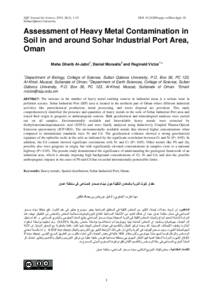Document
Assessment of heavy metal contamination in soil in and around Sohar industrial port area, Oman.
Identifier
DOI: 10.24200/squjs.vol24iss1pp1-10
Source
Sultan Qaboos University Journal for Scientific. v. 24, no. 1, p. 1-10.
Contributors
Moraetis, Daniel., Author
Victor, Reginald., Author
Other titles
مقدار تلوث التربة بالمعادن الثقيلة حول ميناء صحار الصناعي في سلطنة عمان.
Country
Oman.
City
Muscat.
Publisher
College of Science, Sultan Qaboos University.
Gregorian
2019-05-21
Language
English
English abstract
The increase in the number of heavy metal emitting sources in industrial areas is a serious issue in pollution science. Sohar Industrial Port (SIP) area is located in the northern part of Oman where different industrial activities like petrochemical production, metal processing, and waste disposal are prevalent. This study comprehensively identified the presence and quantities of heavy metals in the soils of Sohar Industrial Port area and traced their origin to geogenic or anthropogenic sources. Bulk geochemical and mineralogical analyses were carried out on all samples. Environmentally available and bioavailable heavy metals were extracted by diethylenetriaminepentaacetic acid (DTPA) and were finally analyzed using Inductively Coupled Plasma-Optical Emission spectrometry (ICP-OES). The environmentally available metals that showed higher concentrations when compared to international standards were Ni and Cd. The geochemical evidence showed a strong geochemical signature of the ophiolite rocks in the soils as indicated by the significant correlation between Cr and Ni (P 0.05). In addition, the Cd content showed significant correlations with Ni and Cr (P 0.05). Other metals like Pb and Zn, possibly also were geogenic in origin, but with significantly elevated concentrations in samples close to a national highway (P 0.05). The present study demonstrated the significance of understanding the geological framework of an industrial area, which is already imposing high background concentrations of Cr, Ni and Cd, and also the possible anthropogenic impacts in the cases of Pb and Cd that exceeded internationally permissible limits.
ISSN
2414-536X
Arabic abstract
تعد الزيادة في عدد مصادر انبعاث المعادن الثقيلة في المناطق الصناعية مشكلة خطيرة في علم التلوث. تقع منطقة ميناء صحار الصناعي في الجزء الشمالي من سلطنة عمان حيث تنتشر الأنشطة الصناعية المختلفة مثل إنتاج البتروكيماويات ومعالجة المعادن والتخلص من النفايات. حددت هذه الدراسة بشكل شامل وجود وكميات المعادن الثقيلة في التربة في منطقة ميناء صحار الصناعي وتتبع أصلها إلى مصادر جيولوجية أو بشرية. تم إجراء التحاليل الجيوكيميائية والمعدنية بالجملة على جميع العينات. تم استخلاص المعادن الثقيلة المتوفرة بيئيًا والمتوفرة بيولوجيًا بواسطة حمض ثنائي إيثيلين تريامينبنتا أسيتيك (DTPA) وتم تحليلها أخيرًا باستخدام قياس طيف الانبعاث البلازمي البصري المقترن حثيًا (ICP-OES). أما المعادن المتاحة بيئياً والتي أظهرت تركيزات أعلى بالمقارنة مع المعايير الدولية فهي Ni وCd. أظهرت الأدلة الجيوكيميائية وجود بصمة جيوكيميائية قوية لصخور الأفيوليت في التربة كما يتضح من الارتباط الكبير بين الكروم والنيكل (P<0.05). بالإضافة إلى ذلك، أظهر محتوى الكادميوم ارتباطات معنوية مع النيكل والكروم (P<0.05). من المحتمل أيضًا أن تكون المعادن الأخرى مثل الرصاص والزنك ذات أصل جيولوجي، ولكن بتركيزات مرتفعة بشكل ملحوظ في العينات القريبة من الطريق السريع الوطني (P <0.05). أظهرت الدراسة الحالية أهمية فهم الإطار الجيولوجي للمنطقة الصناعية، التي تفرض بالفعل تركيزات خلفية عالية من الكروم والنيكل والكادميوم، وكذلك التأثيرات البشرية المحتملة في حالات الرصاص والكادميوم التي تجاوزت الحدود المسموح بها دوليًا.
Category
Journal articles

